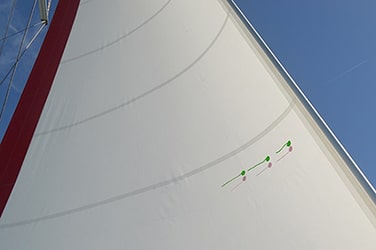The Job of a Sail Trimmer
Sail trimmers in world-class regattas spend years reading and understanding the wind relative to the sails. Sometimes they trim the sheets only a few inches or centimeters. A sail trimmer fully understands aerodynamic lift on the sail and when heading in upwind directions is concerned:
First and foremost – that the tell tales on the lifting side of the sail fly back smoothly.
Second – the telltales on the inside of the sail are flying smoothly.
When heading in downwind directions, the job of the sail trimmer is to maximize the forward-producing force from the two forces, lift and push by trimming the sails to their best position.
Experience, observing the sail shape, looking out for any wrinkles in the sail, and watching the telltales are all key factors in setting the sail. Professional sail trimmers watch for the minutest details.
The bullet points below show you what to expect from different sailing angles to the wind.
30 degrees off the wind.
- The boat is deemed to be on a close haul.
- The force moving the boat forward is all from the lifting power of the airfoil shape.
- The mainsail is pulled toward the centerline of the boat the maximum amount.
- You’re ensuring that the wind is flowing smoothly around the front of each sail.
- Tell tales on the outside of the sail must be flowing smoothly.
- Tell tales on the inside of the sail should also be flowing smoothly.
- The leading edge of the sail is not folding in on itself
60 degrees off the wind
- The boat is deemed to be on a close reach.
- The force moving the boat forward is all from the lifting power of the airfoil shape.
- The sails are let out from the centerline of the boat.
- You’re ensuring that the wind is flowing smoothly around the front of the sail.
- Tell tales on the outside of the sail must be flowing smoothly.
- Tell tales on the inside of the sail should also be flowing smoothly.
- The leading edge of the sail is not folding in on itself
90 degrees off the wind
- The boat is deemed to be on a beam reach.
- The force moving the boat forward is beginning to be shared between the lifting power of the airfoil shape and the pushing power of the wind.
- The sails are let out most of the way towards the beam (side) of the boat.
- You’re ensuring that the wind is flowing smoothly around the front of the sail.
- Tell tales on the outside of the sail must be flowing smoothly.
- Tell tales on the inside of the sail should also be flowing smoothly.
- The leading edge of the sail is not folding in on itself
120 degrees off the wind
- The boat is deemed to be on a broad reach.
- The force moving the boat forward is partially from the lifting power of the airfoil shape but mostly from the pushing power of the wind.
- The sails are let out abeam of the boat.
- You’re ensuring that the wind is flowing smoothly around the front of the sail.
- Tell tales on the outside of the sail must be flowing smoothly.
- Tell tales on the inside of the sail will begin to become uncontrollable (that’s ok).
- The leading edge of the sail is not folding in on itself
After 120 degrees off the wind.
At this point of sail, you can no longer expect the wind to wrap itself nicely around the curvature of the sail to create any lift and you’ll see the outer telltales stalling. This is expected and is OK because the boat is being driven by all pushing force.
- The boat is deemed to be on a run.
- The force moving the boat forward is from the pushing power of the wind.
- The sails are let out abeam of the boat and lightly resting on the side stay rigging
- You’re not worrying about the telltales
- The main sail will be shielding the wind onto the head sail and the head sail will begin “Wallowing” (flapping side to side).
- You’ll probably be looking to move the head sail or mainsail to the other side of the boat so that both sails are being pushed by the wind.
What this means is that from 30 degrees off the wind to 120 degrees off the wind, you’re trying to make the telltales fly on both sides of the sail. But it gets a bit more complicated than just that – read on!





